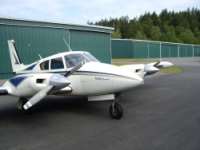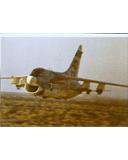Twin Comanche performance up High
12 posts
• Page 1 of 1
Twin Comanche performance up High
How well does a N/A Twin Comanche perform in the mid-high teens? Many times my mission calls for travel above 15,000 ft to clear icy clouds. I know my 180 Comanche is pretty weak up high. Does the Twinkie do a bit better up high?
-

T210DRVR - ICS member

- Posts: 117
- Joined: Sat May 03, 2008 4:31 am
- Location: So. Oregon
My 1969 PA30 is normally aspirated, with overhauled engines now at 1200 SMOH, though with good compression on all cylinders. We tested high altitude performance last Fall under near-standard conditions. Clearly performance is best at 6000 - 8000 feet, and I typically climb there at 120 - 130 KIAS with a climb rate of 750 - 800 fpm. MP starts to drop off above 7000 and true airspeed no longer climbs with altitude -- though fuel flows also start dropping fast!
Nevertheless, we were able to climb at 500+ fpm on up through about 14500 feet. Above that, climb rates were more anemic through 16000 (say 300 - 400 fpm). Above 16000, we step-climbed about 1000 feet per step, stopping at each altitude for a few minutes to accelerate again. We gave up at 19,000 but could have gone on higher. However at that altitude, our MP was down to around 18 inches. Performance there was very satisfactory, though I can't quote you TAS or percent power figures.
We gave up before we reached service ceiling (nominally 20,000 feet for the PA30), but I suspect we could have reached it without too much difficulty.
Practically speaking, I think that 15000 or 16000 is about as high as I would want to fly on a regular basis without turbochargers.... However, I would imagine that the combined 320 horsepower of the Twin Comanche's two IO-320s is going to do a bit better up at those altitudes than the single 180 horsepower IO-360.... and getting up to 18000+ is clearly feasible in the Twinkie.
Nevertheless, we were able to climb at 500+ fpm on up through about 14500 feet. Above that, climb rates were more anemic through 16000 (say 300 - 400 fpm). Above 16000, we step-climbed about 1000 feet per step, stopping at each altitude for a few minutes to accelerate again. We gave up at 19,000 but could have gone on higher. However at that altitude, our MP was down to around 18 inches. Performance there was very satisfactory, though I can't quote you TAS or percent power figures.
We gave up before we reached service ceiling (nominally 20,000 feet for the PA30), but I suspect we could have reached it without too much difficulty.
Practically speaking, I think that 15000 or 16000 is about as high as I would want to fly on a regular basis without turbochargers.... However, I would imagine that the combined 320 horsepower of the Twin Comanche's two IO-320s is going to do a bit better up at those altitudes than the single 180 horsepower IO-360.... and getting up to 18000+ is clearly feasible in the Twinkie.
- MillenniumFlight
- ICS member

- Posts: 25
- Joined: Fri May 09, 2008 3:13 pm
-

Zach Grant L1011jock - Technical Advisor
- Posts: 1404
- Joined: Mon Mar 22, 2004 4:35 pm
- Location: Indianapolis KEYE
-

Zach Grant L1011jock - Technical Advisor
- Posts: 1404
- Joined: Mon Mar 22, 2004 4:35 pm
- Location: Indianapolis KEYE
Re: Twin Comanche performance up High
Rich Clover
-

ics-12766 - ICS member

- Posts: 277
- Joined: Fri Oct 22, 2004 6:10 am
- Location: Evanston, WY (KEVW)
12 posts
• Page 1 of 1
Return to Maintenance - General
Who is online
Users browsing this forum: No registered users and 1 guest
